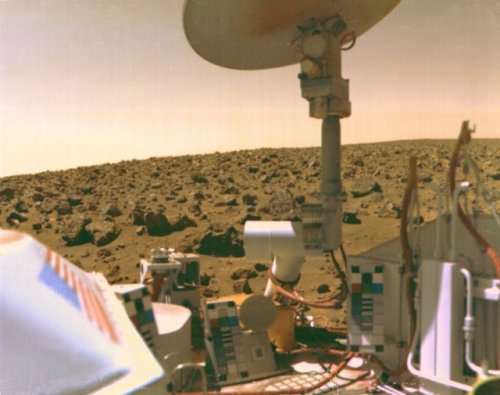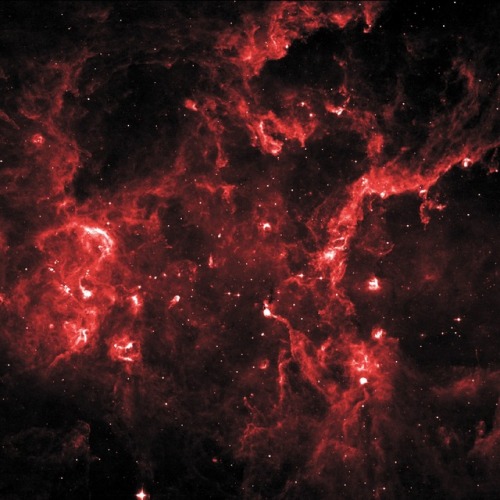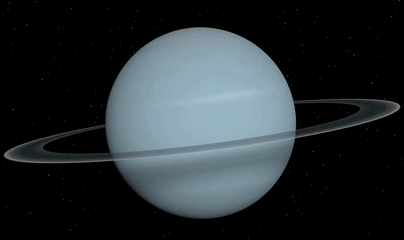The Extraordinary Core Of A Neutron Star

The Extraordinary Core of a Neutron Star
Lucy Reading-Ikkanda/Quanta Magazine; Source: Feryal Özel
More Posts from Xyhor-astronomy and Others

Curiosity drill site reveals that under its red surface, Mars is grey-blue
via reddit

A boulder-strewn field of red rocks stretches across the horizon in this self-portrait of Viking 2 on Mars’ Utopian Plain. Viking 2 landed Sept. 3,1976, some 4,600 miles from the twin Viking 1 craft, which touched down on July 20.
Image Credit: NASA/JPL

Young Stellar Grouping in Cygnus X
Cygnus X hosts many young stellar groupings. The combined outflows and ultraviolet radiation from the region’s numerous massive stars have heated and pushed gas away from the clusters, producing cavities of hot, lower-density gas.
In this 8-micron infrared image, ridges of denser gas mark the boundaries of the cavities. Bright spots within these ridges show where stars are forming today.
Credit: NASA/IPAC/MSX
How to Discover a Planet: A short step-by-step guide on how each of our planetary neighbors were originally discovered.
Coffee in Space: Keeping Crew Members Grounded in Flight
Happy National Coffee Day, coffee lovers!
On Earth, a double shot mocha latte with soymilk, low-fat whip and a caramel drizzle is just about as complicated as a cup of coffee gets. Aboard the International Space Station, however, even just a simple cup of black coffee presents obstacles for crew members.

Understanding how fluids behave in microgravity is crucial to bringing the joys of the coffee bean to the orbiting laboratory. Astronaut Don Pettit crafted a DIY space cup using a folded piece of overhead transparency film. Surface tension keeps the scalding liquid inside the cup, and the shape wicks the liquid up the sides of the device into the drinker’s mouth.

The Capillary Beverage investigation explored the process of drinking from specially designed containers that use fluid dynamics to mimic the effect of gravity. While fun, this study could provide information useful to engineers who design fuel tanks for commercial satellites!

The capillary beverage cup allows astronauts to drink much like they would on Earth. Rather than drinking from a shiny bag and straw, the cup allows the crew member to enjoy the aroma of the beverage they’re consuming.

On Earth, liquid is held in the cup by gravity. In microgravity, surface tension keeps the liquid stable in the container.

The ISSpresso machine brought the comforts of freshly-brewed coffees and teas to the space station. European astronaut Samantha Cristoforetti enjoyed the first cup of espresso brewed using the ISSpresso machine during Expedition 43.


Now, during Expedition 53, European astronaut Paolo Nespoli enjoys the same comforts.

Astronaut Kjell Lindgren celebrated National Coffee Day during Expedition 45 by brewing the first cup of hand brewed coffee in space.

We have a latte going on over on our Snapchat account, so give us a follow to stay up to date! Also be sure to follow @ISS_Research on Twitter for your daily dose of space station science.
Make sure to follow us on Tumblr for your regular dose of space: http://nasa.tumblr.com.
Oldest recorded solar eclipse helps date the Egyptian pharaohs

UNIVERSITY OF CAMBRIDGE—Researchers have pinpointed the date of what could be the oldest solar eclipse yet recorded. The event, which occurred on 30 October 1207 BC, is mentioned in the Bible, and could have consequences for the chronology of the ancient world.
Using a combination of the biblical text and an ancient Egyptian text, the researchers were then able to refine the dates of the Egyptian pharaohs, in particular the dates of the reign of Ramesses the Great. The results are published in the Royal Astronomical Society journal Astronomy & Geophysics.
The biblical text in question comes from the Old Testament book of Joshua and has puzzled biblical scholars for centuries. It records that after Joshua led the people of Israel into Canaan - a region of the ancient Near East that covered modern-day Israel and Palestine - he prayed: “Sun, stand still at Gibeon, and Moon, in the Valley of Aijalon. And the Sun stood still, and the Moon stopped, until the nation took vengeance on their enemies.” Read more.

Take in the Surreal Beauty of Jupiter in These Incredible New Images NASA released the raw data earlier this week, allowing the public to process the beautiful images


Planet Uranus ♅
Equatorial Diameter: 51.118 km
Satellites: 27
Notable satellites: Oberon, Titania, Miranda, Ariel & Umbriel
Orbit Distance: 2.870.658.186 km (19 AU)
Orbit Period: 84 Earth years
Surface Temperature: -220°C
Discovered Date: March 13th 1781
Discovered By: William Herschel
Image credit: Oscar Malet
-
 batchewana liked this · 3 years ago
batchewana liked this · 3 years ago -
 thematicaudience liked this · 4 years ago
thematicaudience liked this · 4 years ago -
 ghidrah reblogged this · 4 years ago
ghidrah reblogged this · 4 years ago -
 ohmyoverland liked this · 4 years ago
ohmyoverland liked this · 4 years ago -
 kikoutei reblogged this · 4 years ago
kikoutei reblogged this · 4 years ago -
 king-of-kaoss liked this · 4 years ago
king-of-kaoss liked this · 4 years ago -
 kikoutei liked this · 4 years ago
kikoutei liked this · 4 years ago -
 graylibrary reblogged this · 4 years ago
graylibrary reblogged this · 4 years ago -
 twobellsilence liked this · 4 years ago
twobellsilence liked this · 4 years ago -
 24kocylinder reblogged this · 4 years ago
24kocylinder reblogged this · 4 years ago -
 dalecooper-official reblogged this · 5 years ago
dalecooper-official reblogged this · 5 years ago -
 dalecooper-official liked this · 5 years ago
dalecooper-official liked this · 5 years ago -
 adiposeclot liked this · 5 years ago
adiposeclot liked this · 5 years ago -
 sunshine-redwine-peregrination liked this · 5 years ago
sunshine-redwine-peregrination liked this · 5 years ago -
 mrscrocombe liked this · 5 years ago
mrscrocombe liked this · 5 years ago -
 skycolors8 liked this · 5 years ago
skycolors8 liked this · 5 years ago -
 vandallas1 liked this · 5 years ago
vandallas1 liked this · 5 years ago -
 ace-pervert liked this · 5 years ago
ace-pervert liked this · 5 years ago -
 super-lurker reblogged this · 5 years ago
super-lurker reblogged this · 5 years ago -
 actuallyrichietozier liked this · 5 years ago
actuallyrichietozier liked this · 5 years ago -
 demuthjr liked this · 5 years ago
demuthjr liked this · 5 years ago -
 doikayt liked this · 5 years ago
doikayt liked this · 5 years ago -
 bli1404 liked this · 5 years ago
bli1404 liked this · 5 years ago -
 16fahri liked this · 5 years ago
16fahri liked this · 5 years ago -
 fagdykefrank liked this · 5 years ago
fagdykefrank liked this · 5 years ago -
 mysticqueen-bee liked this · 5 years ago
mysticqueen-bee liked this · 5 years ago -
 yellowfantress2 liked this · 5 years ago
yellowfantress2 liked this · 5 years ago -
 spocks-pointy-ears liked this · 5 years ago
spocks-pointy-ears liked this · 5 years ago -
 isodil liked this · 5 years ago
isodil liked this · 5 years ago -
 impulsive-astrophile reblogged this · 5 years ago
impulsive-astrophile reblogged this · 5 years ago -
 impulsive-astrophile liked this · 5 years ago
impulsive-astrophile liked this · 5 years ago -
 sofiajkp liked this · 5 years ago
sofiajkp liked this · 5 years ago -
 attingerecaelumdigitto liked this · 5 years ago
attingerecaelumdigitto liked this · 5 years ago -
 silentwhale liked this · 5 years ago
silentwhale liked this · 5 years ago -
 emilythespiderqueene liked this · 5 years ago
emilythespiderqueene liked this · 5 years ago -
 edgy-gremlin liked this · 5 years ago
edgy-gremlin liked this · 5 years ago -
 coolhandcomic liked this · 5 years ago
coolhandcomic liked this · 5 years ago -
 specter06 liked this · 5 years ago
specter06 liked this · 5 years ago -
 scootis-the-scoot liked this · 5 years ago
scootis-the-scoot liked this · 5 years ago -
 jasper-dreams-defunct liked this · 5 years ago
jasper-dreams-defunct liked this · 5 years ago -
 lucillaenchantress liked this · 5 years ago
lucillaenchantress liked this · 5 years ago
For more content, Click Here and experience this XYHor in its entirety!Space...the Final Frontier. Let's boldly go where few have gone before with XYHor: Space: Astronomy & Spacefaring: the collection of the latest finds and science behind exploring our solar system, how we'll get there and what we need to be prepared for!
128 posts